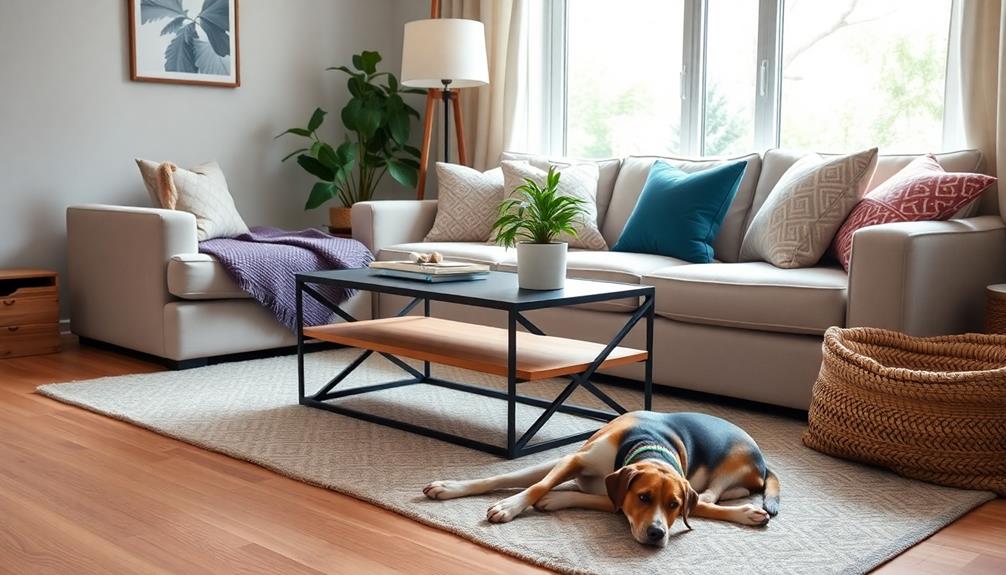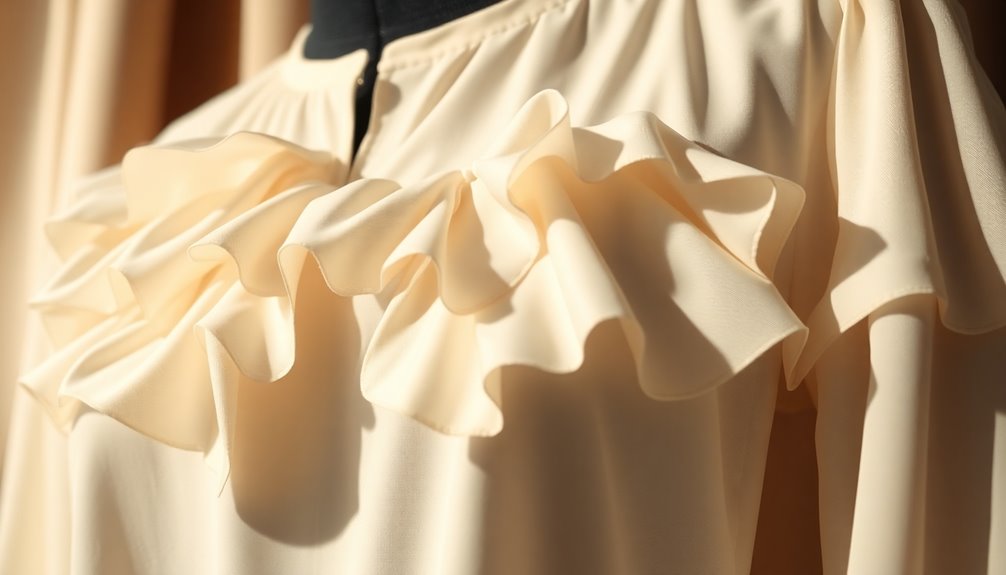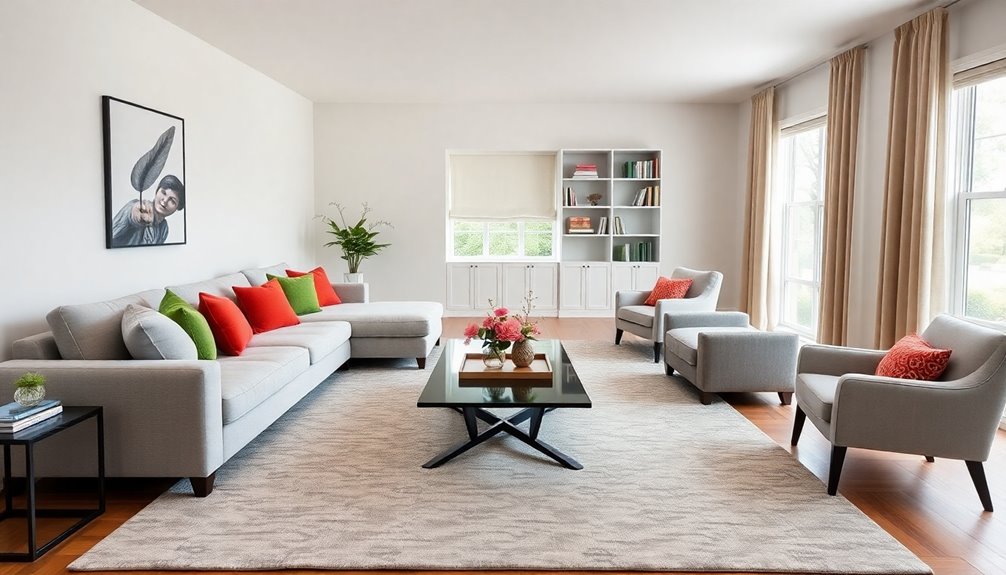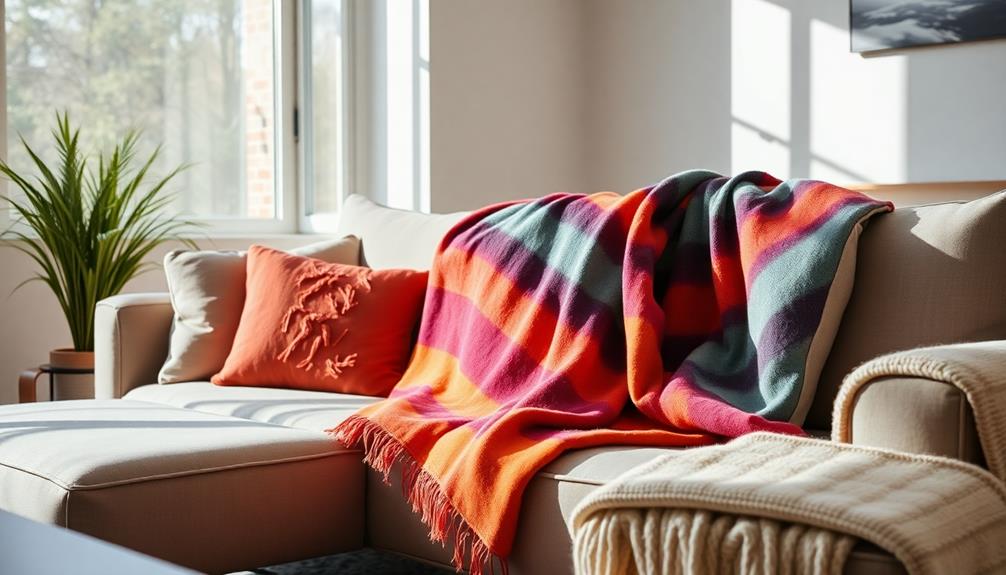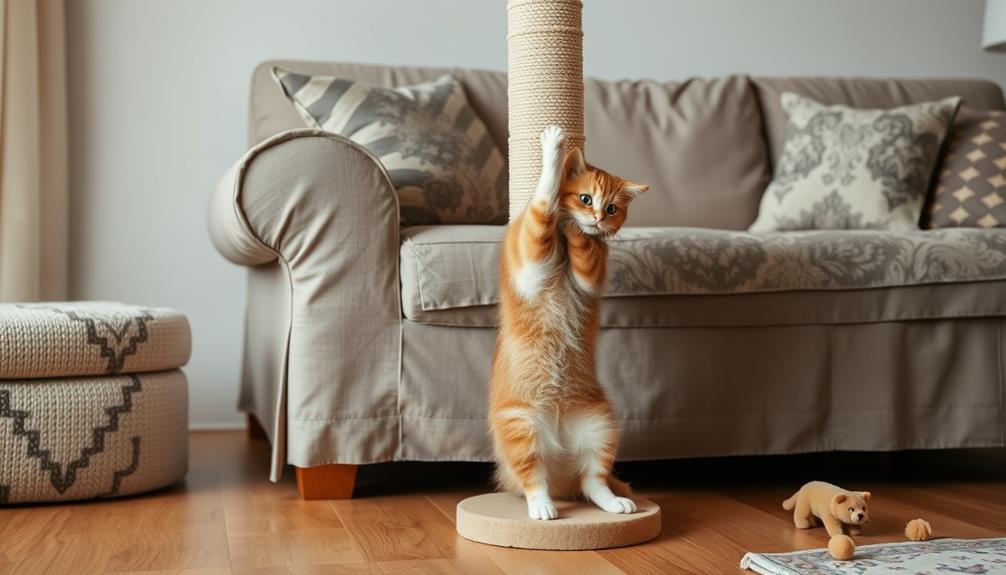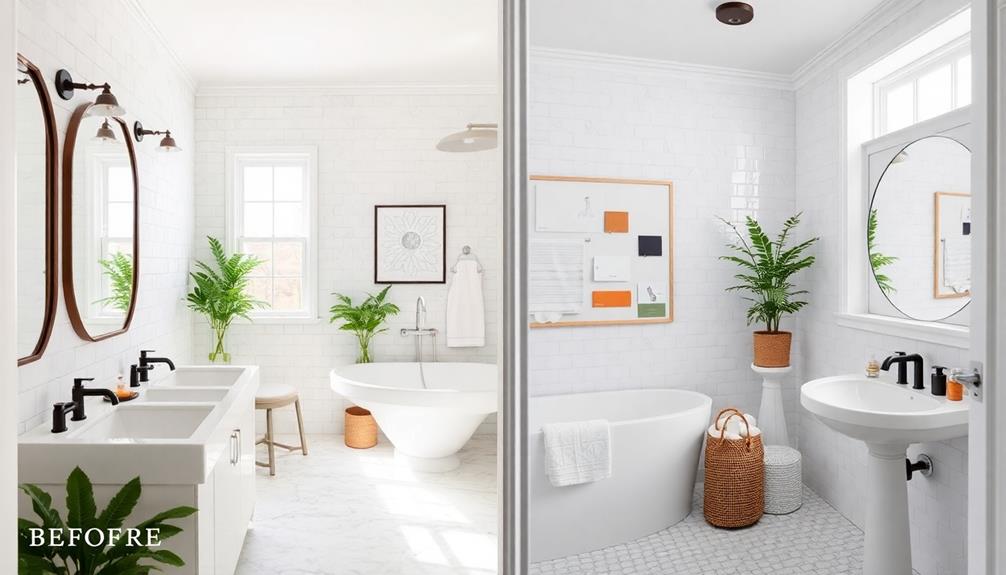To prevent your dogs from getting on the furniture, you must establish clear boundaries and enforce consistent rules. Begin by assigning specific areas, such as comfortable dog beds, where they can relax. Use firm commands like “off” and reward positive behavior with treats and praise when they follow the rules. Visual barriers, like baby gates, can be useful in limiting their access to furniture. Additionally, provide engaging toys to divert their attention elsewhere. Remember, consistency and patience are crucial in this training process. If you are interested in learning more strategies, there is a wealth of information available to help you succeed.
Key Takeaways
- Designate specific areas for your dog, like dog beds, to encourage them to relax outside of furniture.
- Use consistent commands such as "off" or "down" to reinforce furniture boundaries.
- Reward your dog with treats or praise when they choose their designated area over furniture.
- Provide engaging toys and chew items to distract them from seeking furniture comfort.
- Maintain consistency across all household members to avoid confusion in enforcing furniture rules.
Understanding Dog Behavior
Understanding your dog's behavior is essential if you want to keep them off the furniture. Dogs naturally gravitate toward soft surfaces for comfort and warmth, so it's no surprise they seek out your couch or bed. If you allowed this behavior in puppyhood, it can develop into a habit that's tough to break.
As a dog owner, recognizing that your furry friend associates furniture with closeness and security can help you understand their motivations. Additionally, just like with other pets, providing a comfortable and enriching environment is vital for their well-being, as noted in proper diet and care.
Keeping dogs off the furniture requires consistent training and a tailored approach. Some dogs may seek out these spots due to anxiety or a desire for companionship. To effectively modify this behavior, you need to redirect their attention toward designated areas, like a cozy dog bed. Rewarding your dog with treats and praise every time they choose their own space reinforces the behavior over time. It’s also important to ensure that the furniture remains an unattractive option—using barriers or deterrent sprays can help. While focusing on training your dog, you might also be looking up unrelated tasks, like how to strip paint from furniture, which ironically could be a project to revitalize pet-free areas of your home. Additionally, maintaining a consistent schedule for training sessions ensures that your dog understands the boundaries and expectations. As your dog gradually learns to avoid the furniture, you can focus on other household improvements, such as tackling home projects—maybe even researching **how to strip paint from furniture** to restore pieces that have seen better days. By creating a pet-friendly and well-maintained living space, you’re setting the foundation for a harmonious environment for both you and your furry friend.
Using positive reinforcement is key; reward your dog when they choose their own space instead of your couch.
Establishing Clear Boundaries
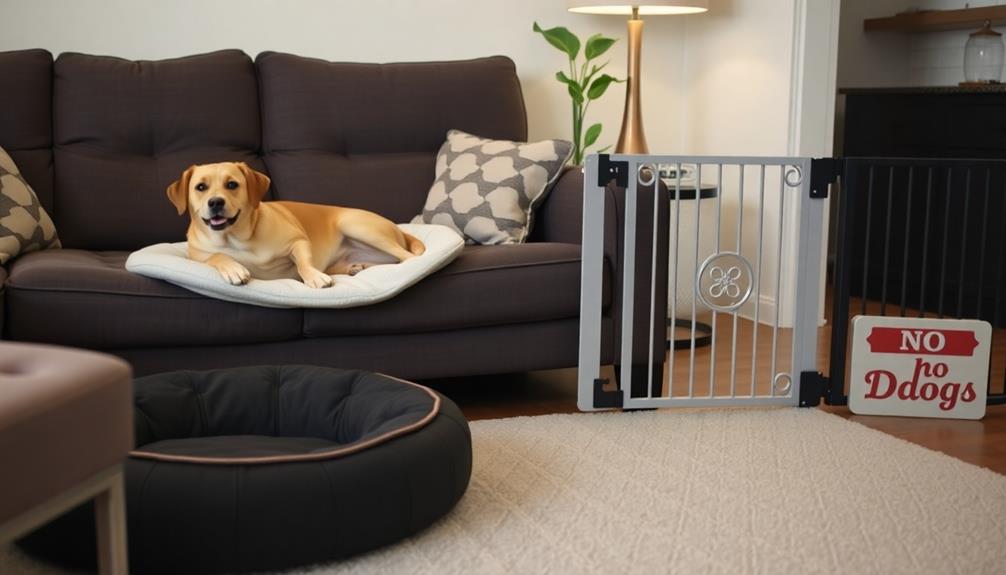
To successfully keep your dog off the furniture, it's crucial to establish clear boundaries right from the start.
Begin by designating specific areas for your dog to relax, like a comfortable dog bed or mat. This creates a distinct separation between allowed spaces and forbidden furniture. Including healthy dog snacks in their designated area can make it more appealing for them to stay there.
Implement consistent commands, such as "off" or "down," to signal when your dog should leave the furniture. This reinforces their understanding of your boundaries and helps them learn the rules.
Visual barriers, like baby gates, can also be effective in physically restricting access to furniture, making it easier for your dog to grasp their limits.
Establish strict rules regarding furniture access early on; mixed signals can lead to confusion and make it harder to enforce boundaries later.
When your dog chooses their designated area instead of the furniture, reward them with treats and praise. This not only reinforces positive behavior but also encourages adherence to the clear boundaries you've set.
Utilizing Positive Reinforcement

Positive reinforcement is a powerful tool for keeping your dog off the furniture. This method involves rewarding your dog with treats, praise, or playtime for behaviors that align with your goals.
It's important to remember that emotional and psychological growth occurs in stages when training your dog, as patience and time are essential. Start by establishing a clear command, like "off." When your dog complies, immediately reward them to reinforce the desired action effectively.
As you train your dog, gradually increase the duration they stay off the furniture before providing rewards. This helps build self-control and clarifies the boundaries you've set.
Consistency is vital—ensure everyone in your household uses the same commands and rewards. Mixed signals can confuse your dog and hinder progress.
Tracking your dog's progress and celebrating small victories can maintain motivation for both you and your pup. Recognizing even the tiniest steps towards your goal can reinforce positive behavior and make training more enjoyable.
If you're unsure, consulting a dog trainer can provide additional strategies tailored to your dog's specific needs. By focusing on positive reinforcement and being consistent in your approach, you'll be well on your way to successfully keeping your dog off the furniture.
Engaging Alternatives and Distractions
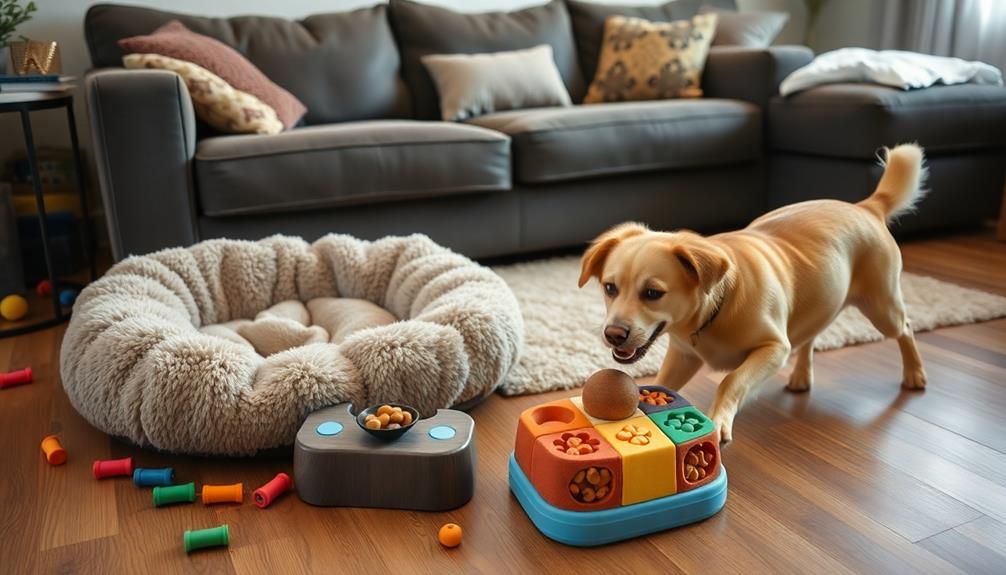
Engaging your dog with alternatives and distractions can markedly reduce their desire to jump on furniture. Start by providing engaging toys or chew items that divert their attention, similar to how unique beetroot recipes for baby-led weaning offer healthy and vibrant options for infants. This not only keeps them entertained but also reduces their need to seek comfort or play on your couch.
Regularly rotating these toys helps maintain their interest and prevents boredom, which can lead to unwanted furniture climbing.
Incorporate puzzle toys to encourage mental engagement. These toys promote cognitive development and problem-solving skills while keeping your dog distracted from the furniture.
Establishing a routine that includes multiple play sessions and exercise can also help expend excess energy. When dogs are physically and mentally stimulated, they're less likely to look for relaxation spots on your furniture.
Additionally, offer cozy alternatives like dog beds or blankets in appealing locations. This encourages your dog to settle in these designated resting spots, reinforcing positive behavior through comfort.
Consistency and Patience in Training
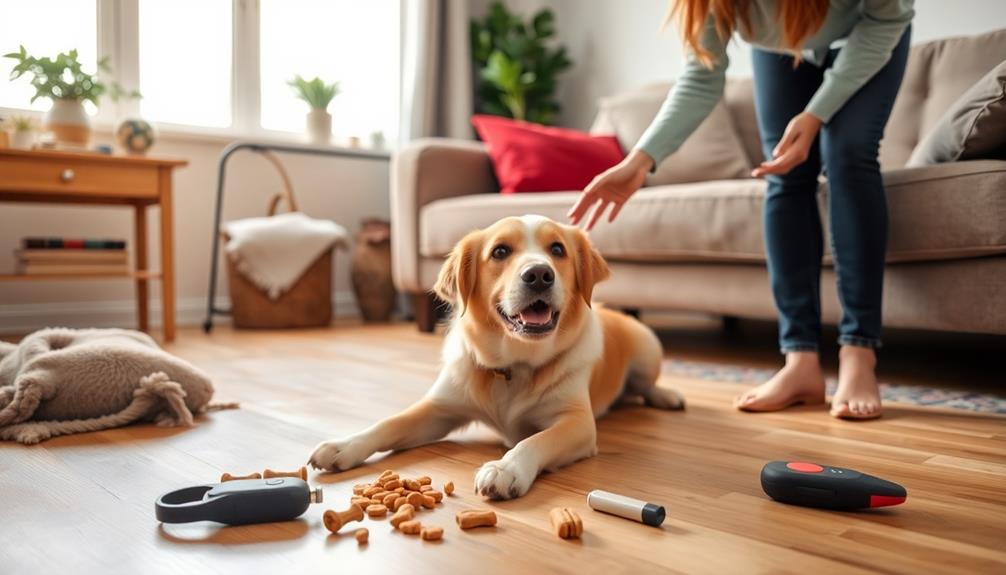
Consistently enforcing training rules is essential for success when teaching your dog to stay off the furniture. All household members need to be on the same page about the rules to avoid confusing your dog.
Establishing a routine for training sessions helps reinforce learning; dogs thrive on predictability and structure. Just like managing a budget requires tracking income and expenses, keeping a consistent training schedule helps you measure your dog's progress effectively. This deliberate approach can lead to better outcomes in training, much like setting specific savings goals can enhance financial health budget management strategies.
Patience is key in this process. Behavior modification takes time and repetition, so don't expect immediate results. Focus on gradual progress rather than quick fixes.
Tracking your dog's progress allows you to adjust your strategies based on their individual responses, keeping you both motivated.
As you navigate this training journey, it's important to celebrate small victories. Acknowledging even minor successes helps maintain enthusiasm and commitment to long-term behavioral change. Each time your dog chooses the designated spot instead of the furniture, recognize that win!
Frequently Asked Questions
What Can I Put on Furniture to Keep Dogs Off?
To keep dogs off furniture, try placing double-sided tape on surfaces, using upside-down carpet runners for discomfort, or employing scat mats that emit noise. These methods can effectively deter your dog from jumping up.
How Do I Get My Dog to Stay off the Furniture?
To get your dog to stay off the furniture, establish clear boundaries with commands, provide a cozy alternative, use positive reinforcement, and implement physical barriers if necessary. Consistency is key for successful training.
How Do I Stop My Dog From Climbing on Furniture?
To stop your dog from climbing on furniture, establish boundaries, provide alternatives, and use physical barriers. Consistently reward good behavior, reinforce commands, and make certain everyone in your household follows the same rules for success.
How Do You Make Furniture Dog Proof?
To make furniture dog-proof, use protective covers, install physical barriers, and apply deterrent products. Rotate engaging toys near dog beds and maintain consistent training to keep your dog focused and away from the furniture.
Conclusion
You might think it's impossible to keep your dog off the furniture, but with the right approach, it can be done! By understanding their behavior and setting clear boundaries, you'll create a comfortable space for both you and your furry friend. Remember, consistency and patience are key. Instead of feeling frustrated, embrace the training journey and enjoy discovering the alternatives that keep your pup engaged. Soon enough, your home will feel cozy and dog-friendly without the couch chaos!
